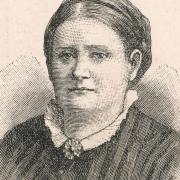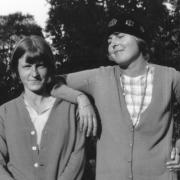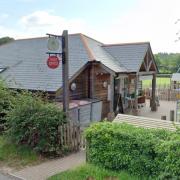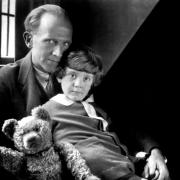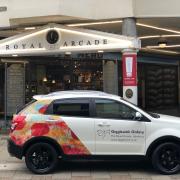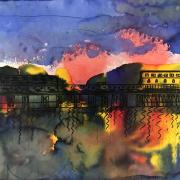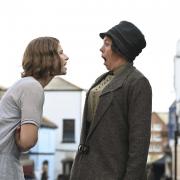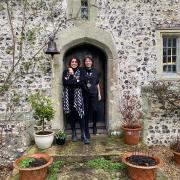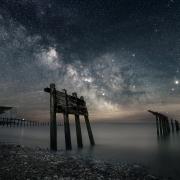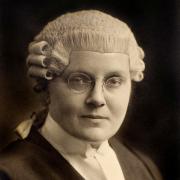Ahead of International Women’s Day we salute the triumphs of Sussex women throughout history and the overdue recognition of a local suffragette
‘She is a long forgotten Sussex heroine,’ muses charity chair Jean Calder. 'Until recently her extraordinary life and sacrifice had been almost entirely erased.’ Jean looks down at a sepia photograph of Mary Clarke, a slight woman in Edwardian clothes gazing into the middle distance.

Although known for her gentleness and not physically robust, the composed image belies the fact that after escaping an abusive marriage, the younger sister of Emmeline Pankhurst - who became a household name after founding the suffrage movement - dedicated her life to the battle for equality. On Christmas Day 1910, aged 49, Mary became the first suffragette to die campaigning for the women’s right to vote.
‘Mary’s death never received the publicity of Emily Wilding Davison’s violent end under King George V’s horse on Derby Day 1913,’ says Jean.‘ There is no public memorial for her anywhere in the country. Despite her sacrifice, she is not even one of the 59 suffrage campaigners commemorated on the plinth of the 2018 statue of British suffragist leader Dame Millicent Fawcett in London's Parliament Square.’
Jean, who is Chair of the Sussex-based Mary Clarke Statue Appeal, is at the forefront of the charity that has been formed to create a permanent memorial to Mary in Brighton. So far £16,000 has been raised towards the £50,000 target for a bronze statue the organisers would like to see situated in, or very near, the Royal Pavilion Garden which has close ties with the suffrage crusade.

Mary was born in 1861 in Salford to a radical family and became a decorative artist. With her sister Emmeline she was a co-founder of the National Women's Social and Political Union (WSPU) - which was dubbed the Suffragettes and aimed to get equal voting rights for women - and its paid Organiser for Brighton from 1909 to 1910.
The Brighton branch was one of the most active regional arms of the organisation, whose motto was ‘Deeds not Words’, and suffragettes campaigned in streets and parks as well as disrupting political meetings held at the Dome.
‘During her time as WSPU Organiser in Brighton, Mary lodged with local suffragette Minnie Turner, in her boarding house Sea View at 13 Victoria Road,’ explains Jean. ‘From this address and the WSPU office at the Quadrant near Brighton’s clock tower, she helped build the WSPU operation in the South East of England.
‘She was greatly loved and respected for her gentleness, commitment and courage and for her ability to use reason, intelligence and good humour to counter hostile crowds.’
On an almost daily basis Mary addressed gatherings of several hundred people on Brighton seafront and Sylvia Pankhurst, Emmeline’s daughter, said her aunt handled ‘Brighton rowdies’ with calm good humour and wit.
Mary played a key role in organising the 1910 General Election campaigns which involved gathering petitions to lobby the government to give women the vote. On 18 November 1910, she took part in the demonstration outside Parliament that became known as Black Friday.
‘Over a six-hour period, 300 women were brutally beaten and deliberately sexually assaulted by uniformed and plain-clothed police, almost certainly acting on Home Office orders,’ says Jean.‘ Mary was injured and deeply distressed, remaining bedridden for the next three days.
‘Though friends tried to dissuade her, on November 22 she left her bed and returned to London with Minnie Turner to protest about the police’s actions. When she heard others of the deputation had been arrested, including her sister Emmeline, she deliberately broke a police station window, almost certainly her first illegal act.’
Mary had been sent to jail twice before - for joining a group of women who tried to hand over a petition to Parliament and after trying to deliver a letter to the Prime Minister. ‘Most suffragettes who were imprisoned had not done anything other than peacefully gather and try to deliver petitions and letters to Parliament,’ says Jean. ‘Emmeline Pankhurst pointed out bitterly that men’s right to do these things were protected by law, but women were held to a different standard. Mary’s first two arrests happened after she had engaged in this sort of peaceful activity.'
This time, Mary was imprisoned for one month. When her sentence was announced she sent a telegram to her Brighton members and declared: ‘One month. I am glad to pay the price for freedom.’ However, she paid the ultimate price after going on hunger strike and being brutally forcibly fed in prison. Two days after her release she collapsed and died of a brain haemorrhage.
She was buried quietly in a family plot in London and John Clarke, to who she was still legally married, inherited her small estate of £60. A memorial meeting was held in the Royal Pavilion the following January and in an emotional speech fellow suffragette Emmeline Pethick-Lawrence, who alongside Emmeline Pankhurst was one of the national leaders of the WSPU, described her as the ‘first woman martyr who has gone to death for this cause.’

Mary's sacrifice has largely gone unnoticed for more than a century.‘ Mary was the first to give her life for women’s right to vote, and thus is of national importance,’ Jean explains. ‘However, her life is an inspiration in many other ways. This shy, gentle women survived domestic abuse, found the courage to engage in political life, endured torture and violence and throughout upheld values of reason and compassion. She is a kind of everywoman, a heroine for our times.’
The organisers of the appeal have commissioned sculptor Denise Dutton to design the statue. Her high profile work includes the statue of suffragette Annie Kenney in Oldham and the Land Girls and Lumber Jills at the National Memorial Arboretum in Staffordshire. She is currently sculpting a statue of pioneering fossil collector Mary Anning for Lyme Regis.

‘We asked her to tell the story of Mary’s life and death and to express her gentle dignity and calm strength as well as her great courage and determination,’ says Jean.
The design, which will be life-size when completed, depicts Mary after leaving prison shortly before her death. She is holding copies of the suffragette newspapers that she sold on Brighton and Hove seafronts and pointing towards a lamp at her feet in a symbolic gesture for others to pick up and continue the suffragette movement, which first saw women over 30 being given the vote in 1918 and voting equally with men over the age of 21 in 1928.

Subject to planning consent, July 2 2023 has been set as the target date for unveiling the statue, marking the 95th anniversary of the Representation of the People (Equal Franchise) Act 1928, which enfranchised all women.

‘We believe a key benefit of acquiring the statue will be the opportunity to raise public awareness and educate children and young people about the importance of women’s rights, equality and democracy, at the same time honouring a brave woman who fought for us all,’ concludes Jean.
To donate or find out more about the Mary Clarke Statue Appeal visit maryclarkestatue.com or email information.mcsa@gmail.com
Five Sussex female pioneers
Mary Ann Gilbert (1776-1845)
Today’s allotments can trace their roots back to this green-fingered innovator who was born into Eastbourne’s wealthy landowning Gilbert family. Troubled by the issue of poverty, in 1830 Mary Ann set about cultivating wasteland at Beachy Head and successfully grew a crop of potatoes. By 1832 around 200 people were renting her plots to grow their own vegetables and keep cows and pigs to feed their families. She also founded agricultural schools in the area.
Marianne North (1830-1890)
Growing up in Hastings, Marianne developed a love of flowers, and plants in the family’s large garden where three greenhouses were kept at different temperatures to nurture plants from around the world. Trailblazing Marianne visited 17 countries on six continents to paint plants, trekking deep into jungles and other wild habitats in her long Victorian skirts. Between 1871 and 1885 she completed 832 paintings which are now housed in her namesake gallery at the Royal Botanic Gardens at Kew.
Mercedes Gleitze (1900-1981)
A typist by day and endurance swimmer in her spare time, in 1927 the Brighton-born Mercedes became the first woman to swim the English Channel. It was her eighth attempt and she reached dry land in 15 hours 15 minutes. The next year she became the first woman to swim the Straits of Gibraltar and in 1933 completed a record-breaking 47-hour swim at Worthing Baths sustained by soup and mackerel sandwiches.
Elizabeth David (1913-1992)
Born in Polegate and buried at Folkington’s St Peter ad Vincula church, the ground-breaking cookery book writer was influenced by a colourful early life which saw her running away to Italy and Greece with a married man. Returning to an England of post-war food rationing and bland dishes she yearned for the fresh and tasty meals she had enjoyed abroad. In 1950 she published A Book of Mediterranean Food which introduced the nation to a whole new way of cooking.
Barbara Hulanicki (1936-)
Cutting her teeth in fashion illustration as a student at Brighton Art School in the 1950s, Barbara Hulanicki went on to transform the face of British high street fashion. In 1964 she opened Biba in Kensington where her trademark floppy hats, feather boas, velvet trouser suits and affordable makeup, epitomised by purple lipstick and nail polish, were displayed against a decadent dimly lit backdrop and sound of loud rock music.




